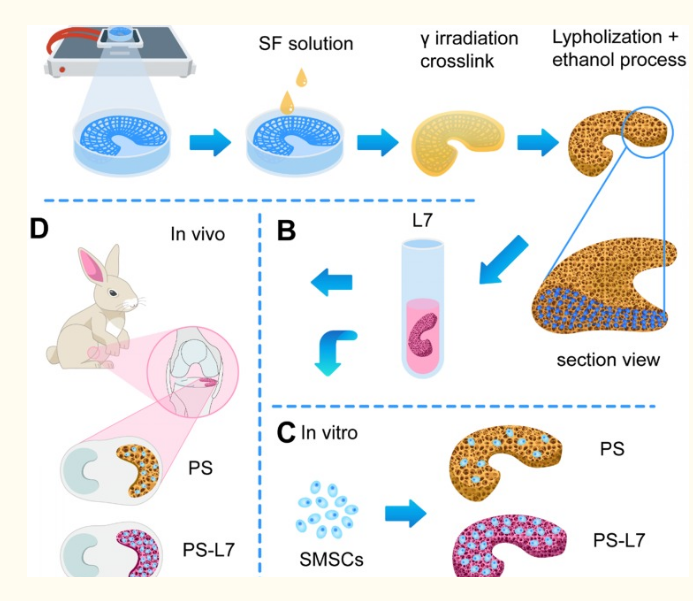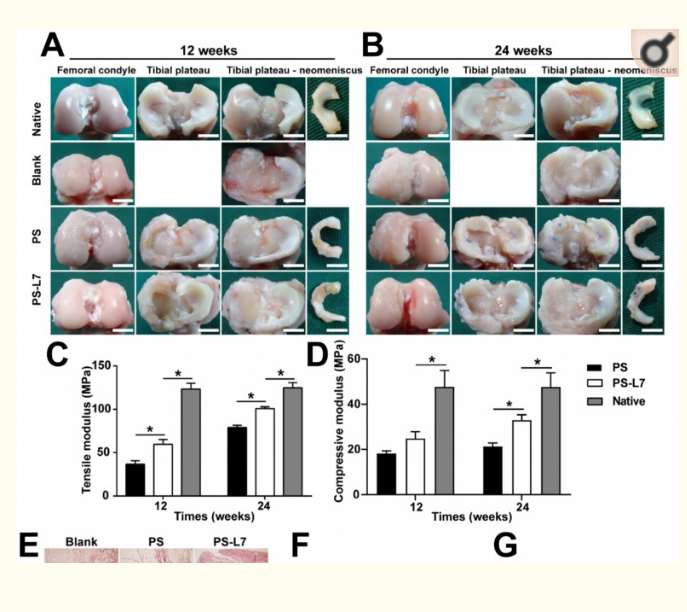Researchers from China are hoping to improve medical outcomes for patients dealing with knee joint issues. Their recent study, ‘Biomechanically, structurally and functionally meticulously tailored polycaprolactone/silk fibroin scaffold for meniscus regeneration,’ outlines their recent study.
Meniscus deficiency is a disease of the knee joints, which can also develop further into osteoarthritis—a degenerative disease that may continue to worsen and cause pain. The authors note that fixing the meniscus can be fraught with difficulties, with today’s most common techniques being meniscus suture, partial or total meniscectomy, and allograft transplantation.
In the hopes that bioprinting could make sweeping changes in the area of regeneration, they have developed a new meniscus scaffold made out of polycaprolactone (PCL)/silk fibroin (SF). Such techniques may be effective, but unfortunately do not ward off osteoarthritis. Allograft transplantation may work also, but research shows that over time results are still shown to be ‘dissatisfactory and uncertain.’
“Also, none of the commercial implants can perfectly restore or permanently replace the natural meniscus tissue, effectively solve the symptoms after meniscectomy, and prevent degenerative cartilage diseases,” state the researchers. “In complex meniscus injuries, the inability of surgical intervention to recover the structural, biomechanical, and functional properties of meniscus remains a great challenge.”
While PCL has been used previously in 3D printing, most studies or experimentation have not been related to strengthening mechanical properties; however, the researchers theorized that PCL could offer the potential for ‘robust’ mechanical properties as well as biomimetic structures. The downside could be ‘risk of attrition of articular cartilage and lack of biological functional bionics.’
Biomimetic meniscus scaffolds were created on a 3D Bioplotter.

Schematic illustration. (A) Fabrication and crosslinking of the scaffolds. (B) Functional optimization of the scaffolds. (C) Biocompatibility assessment in vitro. (D) Implantation in vivo.

Crosslinking procedures of the scaffolds. (A) Proposed cross-linking mechanism of SF under γ-irradiation. (B) Conjugation of L7 peptide onto the scaffolds. (C) Secondary structure changes of SF after ethanol treatment. (D) FTIR spectra of the samples: (1) Pure silk solution, (2) SF after γ-crosslinking and ethanol processing, (3) SF-PCL after γ-crosslinking and ethanol processing, (4) Untreated PCL.
“The pre-created γ-crosslinking network not only provided a preliminary supporting structure for the material system, but also affected the distribution and size of the new physical cross-linker β sheet domains, which contributed to the strength, elasticity, and stability of the SF sponge,” stated the researchers.
As the PS scaffolds begin to show signs of degradation, the researchers noted both slow degradation of PCL as well as more rapid degradation of SF scaffolds. The ratio between samples demonstrated a balance between biomechanical properties, matching the new meniscus.

Biocompatibility, recruitment, and chondrogenic differentiation of SMSCs in the scaffolds in vitro and in vivo. (A) i) SMSC recruitment was verified using immunofluorescence assay after 1-week of implantation with different scaffolds in vivo. ii) Viability of SMSCs was analyzed by Live/Dead staining 3 days after seeding on different scaffolds without chondrogenic incubation. iii) Morphology of SMSCs was observed via Phalloidin/Hoechst assay after 3 days of culturing with different scaffolds without chondrogenic induction. (B) Number of CD29+/CD90+ double-positive cells on different scaffolds in vivo at 1-week post-surgery. (C) Number of effluent cells at 12 and 24 hours after SMSCs were seeded on different scaffolds in vitro. (D) Viability of SMSCs in different groups was observed by alamarBlue assay, and the OD value at each point was normalized against the average of the first day in each group. No significant difference among different groups was observed at the same time point. (E-G) Cartilaginous matrix production in different scaffolds: (E-F) Col I and Col II production quantified by ELISA; (G) GAG assay. (H-K) cartilage-specific gene expression of Col I, Col II, Sox 9, and ACAN (n = 6, *p < 0.05).

Macroscopic observation, biomechanical and inflammation assessment of regenerated meniscus in vivo. (A-B) Macroscopic observation of joints at 12 weeks and 24 weeks after implantation. (scale bar = 10 mm) Medial meniscal excised from the tibial plateau is shown on the right. The Blank group received no implantation after total medial meniscectomy. (C-D) Biomechanical assay of implants at each time point (12 weeks and 24 weeks) (n = 4, *p < 0.05). (E) Histological evidence of the synovium at 1, 3, 6 weeks after surgery (scale bar = 200 µm). (F) Quantitative assay of Interleukin-1 in the synovial fluid at 1, 3, 6, 12, and 24 weeks after surgery. (G) Quantitative assay of tumor necrosis factor-α in the synovial fluid at 1, 3, 6, 12, and 24 weeks after surgery. (n = 6, **p < 0.01 vs 1 week)
“With the advantages of biomimetic architecture, SMSC recruitment ability, and excellent biomechanical characteristics, the scaffold provided an excellent microenvironment for SMSC recruitment, retention, proliferation, differentiation, and ECM production,” concluded the researchers. “Furthermore, the scaffold displayed superior biomechanical properties and excellent anisotropic meniscus regeneration and chondroprotection.”
“Compared with traditional cell-based therapies, the current study provides a novel approach for one-step meniscus repair and regeneration with the advantages of reduced cost and avoiding secondary operation. Thus, the PS-L7 scaffold developed in the current study exhibits tremendous potential for clinical translation in meniscus tissue engineering.”
The meniscus has been the center of other studies related to 3D printing, from 3D printed implants to help with recovery from sports injuries to fabrication of menisci in outer space. What do you think of this news? Let us know your thoughts! Join the discussion of this and other 3D printing topics at 3DPrintBoard.com.
[Source / Images: ‘Biomechanically, structurally and functionally meticulously tailored polycaprolactone/silk fibroin scaffold for meniscus regeneration’]
The post China: Bioprinting Polycaprolactone/Silk Fibroin Scaffolds to Improve Meniscus Regeneration appeared first on 3DPrint.com | The Voice of 3D Printing / Additive Manufacturing.
